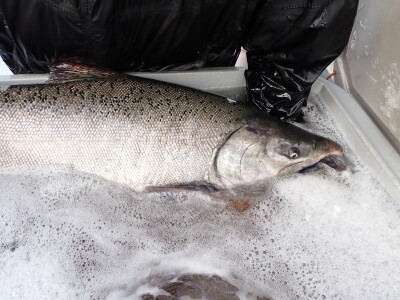Gulf/South Atlantic Mullet
Roe harvesters say conditions are right for good year, but the market is dicey
Fishermen looking to the 2008-09 mullet roe season are likely hoping it won't mimic the '07-08 season. There are plenty of fish, and the red tide wasn't much of a factor, finally, but the volatile roe market let them down.
"Price was terrible," says Karen Bell, manager of A.P. Bell Fish Co., in Cortez, Fla. "Seventy-five cents [a pound for roe fish] was as high as it got."
In good years, roe mullet has brought fishermen well in excess of $1 a pound ex-vessel. But in recent years, U.S. harvesters have seen increased competition from international sources, such as China and, especially this past season, Brazil.
"They attributed it to Brazil contributing so many containers there was no demand for the U.S. mullet," Bell says.
A.P. Bell, which usually exports about four containers a year, only shipped two this past season, she says.
Trying to predict the roe market is as foolhardy an endeavor as a fishery observer might attempt.
However, as long as stocks remain healthy, every October brings a new market situation. And there are some good signs for the coming season.
For one thing, Taiwan, the largest importer (followed by Italy) of American mullet roe, has thus far avoided the economic slump afflicting the United States and Europe, according to a recent analysis in The Economist.
"Real [gross domestic product] growth is forecast to average 4.3 percent a year in 2008-09. This respectable rate of economic growth will help to limit the budget deficit to below 2 percent of GDP over the two-year period," The Economist predicts in a country briefing on Taiwan. Inflation is a concern, though, at this point, less so for Taiwan than most other Asian economies, according to The Economist.
Mullet roe is a favorite at Taiwanese New Year's events, weddings and other celebrations that are more numerous and lavish during times of economic prosperity.
Robust competition from Brazil, China and even Taiwanese-based aquaculture has become a market reality for U.S. roe producers. But the Gulf of Mexico roe is a superior product that should continue to have a fighting chance in the global market. Florida is the largest producer of American mullet roe.
For the first two months of 2008, U.S. frozen roe shipped to Taiwan increased substantially compared with January and February of 2007, from 18,144 kilos worth $269,400 to 62,664 kilos worth $771,835. This development apparently didn't much help Gulf Coast fishermen trying to make some money on their fresh roe late in the season. However, it may be a good sign for the '08-09 season, provided Taiwan avoids the creeping global economic malaise.
Another worry of recent years is subsiding somewhat. The inshore red tides that were widespread, severe and persistent in the heart of West Coast mullet habitat during 2005 and 2006 were by comparison largely absent during calendar year 2007 and remain so thus far in 2008. These events are widely blamed for a huge decrease in mullet production in some hard-hit areas off the West Coast during the '05-06 season.
However, given the resurgence of mullet landings since, it seems likely that mullet stocks simply moved rather than suffering any significant mortality.
Florida's calendar year 2005 landings, at 6.65 million pounds, were the third lowest since the state banned gillnets in 1995 and fishermen had to turn to labor-intensive hand-thrown cast nets.
In 2006, production rebounded nicely, to a respectable 8.62 million pounds in the final accounting by Florida's Fish and Wildlife Research Institute. The 2007 preliminary numbers are similar to the preliminary 2006 landings.
An unseasonably cold spring this year, with a near freeze at least as late as April 17, may well contribute to suppression of the Karenia brevis toxic algae.
Ex-vessel price has indeed been worrisome, dropping from 79 cents a pound on average in 2006 to 64 cents a pound on average in 2007, according to Florida state statistics. Given Bell's observation of a 75-cent high for roe-bearing fish in Cortez late in the season, the 2008 price may not be much better. By comparison, ex-vessel mullet prices averaged 75 cents a pound 11 years ago in Florida, when gasoline for mullet fishermen's fuel-thirsty outboards cost a fraction of its current $3.50 a gallon.
As in every other fishery, fuel price concerns mullet harvesters, too.
"It's just kind of scary," Bell said. "You just don't know where it's going to stop." — Hoyt Childers
Northeast Scallops
Recession fears, fuel cost dampen prices as day boats give way to IFQs
Consumer recession fears and fuel costs are putting brakes on Atlantic scallop prices, just as new regulatory changes fold up the general category day boat fishery, and introduce new individual fishing quotas that some in the industry have resisted for years.
"We're in a recession, I don't care what anyone says," says Rich Canastra of the Whaling City Seafood Display Auction in New Bedford, Mass. Despite a growing disparity in euro-dollar exchange rates that fueled scallop exports in 2007, the European market didn't grow much in early 2008 while domestic demand flattened, he says.
"People aren't going out to eat as much, or buying as much at the fish store," Canastra says. New Bedford spring prices of $6.75 to $7.00 a pound for large scallops were already off 25 to 50 cents a pound from last spring. And fuel costs that nearly doubled in 12 months to $4 a gallon were eating into the bottom line.
"We're seeing fairly strong prices, but we're also seeing a sharp drop in demand. [Price] is too high to support the market," says Ernie Panacek, manager of the Viking Village dock in Barnegat Light, N.J. "I'd say it's a 20 percent decrease.
"High-end seafood is taking a hit in this economy," Panacek adds. "People aren't going out to eat as much. They're looking at their credit cards and gas bills, saying 'Oh my God, we can't go out.'"
Prices were rising early this year, "but a few landings took care of that," says former scalloper Jim Kendall, executive director of the New Bedford Seafood Coalition.
NMFS closed the Elephant Trunk area east of New Jersey to general category boats on March 13, after calculating the fleet had already taken its allocated 865 trips. The Trunk won't open again to the general category until March 2009.
Fishermen have "something like 37 days in the open areas," Kendall says. "So if you're going to take those, you want to plan them just right, around the weather, your best yield and price."
Kendall laughs, a little sadly, and says all those constraints would challenge the best corporate CEOs: "We've got one of the most rebuilt fisheries on the East Coast, and they still don't know how to manage it."
The general category's big ride ends on June 30. The new system of limited access permits takes effect July 1, accompanied by a slow move toward introducing individual fishing quotas that let general category permit holders trade catch shares based on their past participation.
"We've fought this for years in the limited entry fishery," Kendall says.
But this year's introduction of IFQs in the day boat scallop and tilefish sectors clearly show that advocates are persuading managers that individual quotas are the wave of the future.
The new rules will push the strictly day boat fleet back to 5 percent of the fishery — it's been estimated they captured up to 12 percent of landings at one point — and let 369 boats stay in the fishery. Thousands of permits were issued under the old open-access system.
That cuts out most boats that didn't have permits and 1,000 pounds of landings prior to the Nov. 1, 2004, control date, although there is some provision for owners appealing because of circumstances.
New Jersey general category scalloper Ed Blaine was assembling documents in early May for his appeal to retain his permit, on a boat Blaine says he purchased just weeks before the 200
4 control date based on advice from NMFS.
"If I could get 40 days a year [scalloping] I could live on that, because I do other things," says Blaine, who gillnets and catches conch, too.
The general category's least committed fishermen are gone now. Small-boat scallopers say market forces thinned some of their numbers; some latecomers to the fleet simply dropped out once prices fell from highs of $10 and settled into the $5 to $7 range.
Their appetites have also been diminished by high fuel costs, Blaine says.
"I have a very economical engine, and it's costing me $675 a day [for a 24-hour trip]. I hate to think what these 600- or 700-horsepower boats are burning."
The day-boat boom benefited longtime finfish captains, allowing them to add scalloping to their seasonal repertoire.
"Some of the boats redirected their efforts, but not all of them are going to keep those permits," says Erik Anderson of the New Hampshire Commercial Fishermen's Association. — Kirk Moore
North Pacific Halibut
Lower quotas, global shortage point to good prices for Alaska longliners
This year's smaller harvest quota and high demand kicked the halibut season into high gear for Alaska longliners.
World markets are short on overall whitefish supplies, let alone fresh whitefish like halibut. But that didn't stave off the announcement of quota reductions in key production areas made in the weeks preceding the March 8 season opening.
The reductions are based on a different stock assessment model that uses a coastwide estimate of biomass instead of adding up estimates from individual harvest areas. In implementing the assessment model, the International Pacific Halibut Commission called for a coastwide exploitation rate of 20 percent; previous exploitation rates were assigned individually to the harvest areas.
In Area 3A, which encompasses the central Gulf of Alaska, exploitation rates fell from 22.5 percent of the biomass to 20 percent. That translates to a quota reduction from last year's 26.2 million pounds to this year's 24.2 million pounds.
In Area 2C, which lies in the waters of northern Southeast Alaska and the eastern Gulf of Alaska, the changes spell a quota reduction from 8.5 million pounds in 2007 to 6.2 million pounds this year. Areas 4C, 4D and 4E, which lie offshore of the Alaska Peninsula in the Bering Sea, saw quota reductions of up to 7 percent.
Exceptions to the reductions were increases in Area 3B, (from 9.2 million pounds to 11 million pounds) which encompasses Gulf of Alaska waters west of Kodiak, and Area 4B (1.44 million pounds to 1.9 million pounds), which straddles the Aleutian Islands.
Scientific research underpinning the lower quotas suggests a substantial decline in the abundance of fish in the 1987 and 1988 age classes and much slower growth in fish of later age classes that might take their places.
"What we're seeing is that the 1999 and 2000 year classes look really strong, but the growth rate is really slow," says Bruce Leaman, executive director of the International Pacific Halibut Commission, in Seattle. "The growth rate is half of what it was in the 1980s."
Leaman adds that the young halibut are growing so slowly that in some areas 60 percent of the males won't live long enough to reach the legal harvest length of 32 inches. While populations of the younger, yet unharvestable fish may be abundant enough to stress their food sources and stymie their growth rates, Leaman adds that a tenfold increase in populations of arrowtooth flounders in the last decade may be competing for the same forage (mainly small fish) species.
While halibut harvest quotas — and their associated landings — have fallen 14 percent since 2003, ex-vessel revenues have climbed by 26 percent. According to data from NMFS, landings decreased from 57.4 million pounds in 2003 to 49.3 million pounds last year. But revenues during the same time period increased from $167.8 million to $212 million.
Given this year's quota cutbacks and ex-vessel prices of around $4.50 per pound at the close of last year's season, some fishermen speculated that ex-vessel prices early in this year's season would start in similar fashion.
"Pricing is up 60 cents per pound for 10- to 20-pound fish compared to 2007," says Jessica Yeoman, marketing agent with the Auction Block in Homer. Ex-vessel prices as of mid-April in Homer were averaging $4.40 per pound for fish running from 10 to 20 pounds, $4.60 for fish running from 20 to 40 pounds, and fish weighing 40 pounds and up were fetching $4.80 per pound.
Ex-vessel prices vary among ports at various times of the season. But the annual average ex-vessel prices recorded in the Federal Register show a steady climb from $2.93 per pound in 2004 to $3.05 in '05, to $3.67 in '06 to last year's average of $4.30.
"Some buyers are saying that the white tablecloth restaurants are driving the demand for fish," Yeoman says. "However, this is the time of the year that weather rules the market, and frequent gale warnings will naturally dry up supply. So when the first boats come in, the buyers find themselves competitively overpaying for halibut that they all desperately need."
In the meantime, markets will likely remain short, as quotas aren't expected to increase. "Probably not for the next two or three years," Leaman says. — Charlie Ess
Pacific Tuna
Albacore trollers may see demand rise with absence of salmon on the market
One industry's loss could be another's gain. In this case, the closure of the salmon season for most of the West Coast could benefit albacore trollers.
Seafood processors and Wayne Heikkila, executive director of the Western Fishboat Owners Association, say the demand for fresh iced fish likely will be up.
Tuna have no problem with rivers — unlike salmon, Heikkila says, noting that the association's new marketing and public relations campaign is geared to domestic markets. It aims to get albacore into the traditional marketplace that chinook has dominated.
After all, tuna offers many of the same benefits: It's high in protein, has a unique taste and is high in healthy omega-3 fatty acids.
The campaign follows a decade of change from a dependence on major canneries — BumbleBee, StarKist and Chicken of the Sea — to targeting domestic markets, as well as those in Europe and Asia.
"The major canner market is not stellar," Heikkila says, noting that canners also are buying fewer fish.
StarKist did buy trollers' fish last year, but only 1,400 tons out of the 11,000 tons fishboat owners association members caught. In 2006, StarKist bought 5,000 tons.
Part of the drop in purchasing volume reflected canner reluctance to pay more for albacore. The basic brine-frozen price started at $1,400 a ton but went up to $1,600 a ton.
"The price went up last year in August by 50 cents a pound, and they dropped out," Heikkila says. The same product garnered $1,800 a ton in 1980, he says.
It reinforced owners association members' decision to keep their sashimi markets in Europe, Canada and Asia open. Canadian buyers seeking primarily blast-frozen fish for sashimi outlets purchased more than half of the association's total landings in 2007: 6,600 tons.
But last year, it was a buyer's market, Heikkila says. Sashimi-grade blast-frozen fish ex-vessel prices dropped down to the brine-frozen price of around $2,300 per ton.
Albacore trollers, like all fishermen, are facing rising fuel costs. Heikkila says fuel costs have increased 500 percent during the past six years, while trollers are fishing at 1980 prices in most cases
. Even Asian tuna longliners are getting bit by high fuel costs and were making their final deliveries in April before tying up, he says.
Some of the fleet fish the South Pacific in the winter, giving the rest of the West Coast trollers a preview of what to expect come summer. This year, only five vessels went, with one boat having some fair fishing around Christmas. But that was the highlight of the winter fishery, Heikkila says, and most of their earnings probably went to paying fuel bills.
Trollers can expect more boutique canners to be on the lookout for pole- and troll-caught albacore to fill the salmon void. More value-added products, such as pouch-packs and canned products, will fill seafood store shelves.
Even traditional processors are looking to buy tuna this year. Scott Adams, production manager for Hallmark Fisheries, says he will be offloading more tuna vessels in 2008 at the Charleston, Ore., plant and buying some albacore.
Last September, the San Diego–based American Albacore Fishing Association received Marine Stewardship Council certification for the North and South Pacific albacore harvested by association members. That means the MSC certification applies only to AAFA-caught fish.
The association hopes certification will help trollers earn better prices at home and abroad.
The other factor affecting prices is the U.S.-Canada tuna treaty, which regulates the number of Canadian boats allowed to fish U.S. waters. April talks yielded little progress, so default treaty measures are in place for 2008.
In 2003, both countries agreed to reduce the number of vessels fishing in each other's waters. That year, Canadian fishermen trolling in U.S. waters landed 3,400 tons, with U.S. fishermen landing 14,900 tons from those same waters.
And while overall albacore landings have dropped since then, Canadian harvests in U.S. waters last year totaled 300 tons, while American trollers landed 12,200 tons. Hence, American boats benefit from the downturn in Canadian product available to processors.
Meanwhile, West Coast fishermen are hoping albacore can help mitigate lost salmon income.
"Hopefully there will be fish around," Heikkila says. "It sounds like there's going to be some demand." — Susan Chambers






